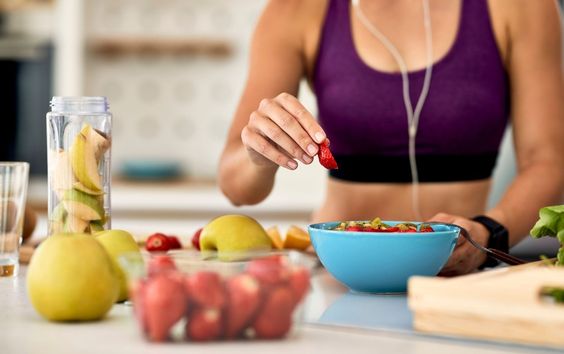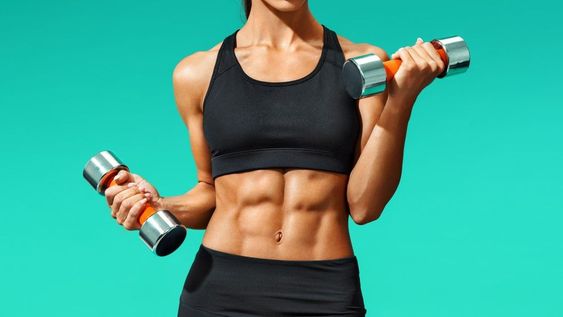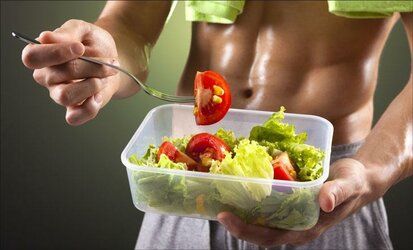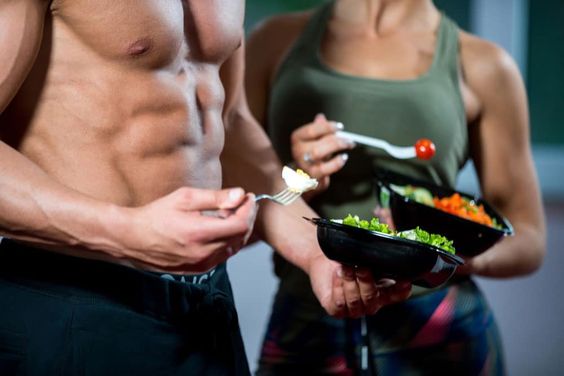If you are a vegetarian and now looking for a suitable Indian diet plan for Six Pack Abs, here are some suggestions, which you must follow to achieve your goal. So here we have a Six Pack abs Indian diet for vegetarians and a vegetarian diet for vitamin b12.
What Is Abs Diet For Vegetarian?
When you are trying out the abs diet for vegetarians then keep one thing in mind being hungry will be worse than overeating. Therefore, filling the stomach at regular intervals is very important. So, let’s now check out a sample 7-day diet plan for vegetarians to build up abs. However, diet alone won’t be enough to build up abs. So, you will also have to practice some exercises along with your diet plan to achieve your goal. Here we go with the vegetarian diet plan along with some effective exercises…
- What Is Abs Diet For Vegetarian?
- Six Pack Abs Diet For Vegetarian:
- 7 Day Diet Plan:
- Try Exercises Along With Your Abs Diet For Vegetarians:
- 15 Vegetarian Protein Foods to Include In Vegetarian Diet:
- Common Vegetarian Diet Mistakes:
- 1. Not Getting Enough Protein:
- 2. Missing Out on Vitamin B12:
- 3. Not Getting Enough Iron:
- 4. Overloading on Processed Foods:
- 5. Not Eating Enough Healthy Fats:
- 6. Too Much Dairy & Cheese:
- 7. Ignoring Omega-3 Fatty Acids:
- 8. Not Planning Balanced Meals:
- 9. Low Calcium Intake:
- 10. Relying Too Much on Meat Substitutes:
- Summary:
- FAQ On Abs Diet For Vegetarian:
To begin with, the abs diet for vegetarians i.e. diet chart for 6-pack abs, keep in mind that being hungry will be worse than overeating. Therefore, consider filling the stomach at regular intervals is very important in your diet plan for 6-pack abs.
You should eat carbohydrates in medium quantities in your diet plan for six packs. Most of your food should contain high amounts of protein and fiber and you should also include foods containing low amounts of fats and sugars in your six-pack diet chart and vegetarian diet for losing weight.
NOTE:
For effective result, you have to consume at least four to five small meals throughout the day, which will save you from eating more. Avoid fatty foods as much as possible.
Six Pack Abs Diet For Vegetarian:
If you are a vegetarian trying to get six-pack abs i.e. diet for making abs Here is the abs diet chart or abs diet for vegetarians below. With the help of this diet chart, you not only get the idea of what to eat but you will also realize what foods to avoid for abs diet for vegetarians.
Breakfast:
Preferably, breakfast should be the biggest meal of the day. Because it gets sufficient time to get digested easily during your daily activities. By having a substantial breakfast, you will also be able to keep the whole functioning throughout the day.
A good breakfast ensures the metabolism of necessary incentives. As a result, calories are assimilated rapidly.
What You Can Eat For Breakfast?
A bowl of green salad with a bowl of brown rice or two whole wheat roti and a small bowl of chickpea curry are best for breakfast in the vegan diet for muscle building.
A glass of freshly made fruit juice or veggie juice is also very healthy.
Make sure you are eating flour made of whole wheat as it contains fewer calories.
Lunch:
For a six-pack abs diet for vegetarians, lunch should be generally lighter than breakfast and should be consumed around 3 hours of breakfast.
What You Can Eat For Lunch?
A small bowl of brown rice or 2 whole wheat roti with bean curry.
A bowl of fruit salad.
Dinner:
In the ideal vegetarian diet chart for abs plan, dinner should be the lightest among the three main meals of the day. Because dinner is taken at the end of the day, after which there is no adequate activity to digest the food.
Therefore, it is difficult to burn the calories consumed at dinner. Unused calories accumulate in the form of fat.
What You Can Eat For Dinner?
Take a bowl of whole wheat pasta, a small size bowl of vegetable salad.
To get six pack Indian diet for abs, you will need an unbearable dedication to stick to your vegan diet for losing weight. However, you can make a good Indian diet for abs for your diet, because what you see here is not difficult at all.
Summary:
When you decide on your diet plan, make sure to have enough variety in the plan to keep it running.
A vegetarian diet plan for six-pack abs is certainly not sufficient to get an amazing Indian diet for six pack abs. You will also have to exercise daily and have to follow the abs diet food list to get a better result.

7 Day Diet Plan:
A sample 7 day Indian diet plan for abs diet for vegetarians. So check out the diet chart for six pack or six pack abs diet food list below
Day 1:
Early Morning (7:00 a.m. – 8:00 a.m.):
- One glass of Protein shake.
Breakfast (9:00 a.m. – 10:00 a.m.):
- A bowl of whole-grain cereal with milk and nuts.
Mid-morning (11 a.m. – 12 p.m.):
- 1 big apple.
Lunch (1:00 p.m. – 2:00 p.m.):
- Mixed veg Quinoa
- Mix veggie salad.
- A glass of fruit juice.
After Lunch (3:00 p.m. – 4:00 p.m.):
- 1 fruit of your choice.
Evening Snack (5:00 p.m. – 6:00 p.m.):
- A handful of nuts
Dinner (8:00 p.m. – 9:00 p.m.):
- Veg clear soup
Bedtime Snack (10:00 p.m. – 11:00 p.m.):
- A glass of fat-free warm milk
Day 2:
Early Morning (7:00 a.m. – 8:00 a.m.):
- One glass of almond milkshake
Breakfast (9:00 a.m. – 10:00 a.m.):
- A bowl of oatmeal with fruits.
- A glass of green veggie juice.
Mid-morning (11 a.m. – 12 p.m.):
- Half grapefruit
Lunch (1:00 p.m. – 2:00 p.m.):
- 2 Whole-grain roti with chickpea sabji
After Lunch (3:00 p.m. – 4:00 p.m.):
- A small bowl of berries.
Evening Snack (5:00 p.m. – 6:00 p.m.):
- A small cup of Chia seed pudding
Dinner (8:00 p.m. – 9:00 p.m.):
- Mix veg salad with tofu
Bedtime Snack (10:00 p.m. – 11:00 p.m.):
- 5 dates
Day 3:
Early Morning (7:00 a.m. – 8:00 a.m.):
- A glass of Banana milkshake.
Breakfast (9:00 a.m. – 10:00 a.m.):
- A Bowl of fruit salad.
- A glass of green juice.
Mid-morning (11 a.m. – 12 p.m.):
- 2 pears
Lunch (1:00 p.m. – 2:00 p.m.):
- A bowl of brown rice with mixed mean sabji.
After Lunch (3:00 p.m. – 4:00 p.m.):
- A small bowl of cherry.
Evening Snack (5:00 p.m. – 6:00 p.m.):
- A cup of fat-free yogurt with berries
Dinner (8:00 p.m. – 9:00 p.m.):
- Mix vegetable soup.
Bedtime Snack (10:00 p.m. – 11:00 p.m.):
- 1 Banana
Day 4:
Early Morning (7:00 a.m. – 8:00 a.m.):
- A glass of protein shake
Breakfast (9:00 a.m. – 10:00 a.m.):
- 2 slices of brown bread with peanut butter.
- A glass of fruit juice.
Mid-morning (11 a.m. – 12 p.m.):
- 1 Banana
Lunch (1:00 p.m. – 2:00 p.m.):
- 1 bowl of brown rice with spinach sabji and dal
After Lunch (3:00 p.m. – 4:00 p.m.):
- 1 guava
Evening Snack (5:00 p.m. – 6:00 p.m.):
- A cup of fat-free yogurt.
Dinner (8:00 p.m. – 9:00 p.m.):
- Vegetable salad with cottage cheese and olive oil.
Bedtime Snack (10:00 p.m. – 11:00 p.m.):
- A glass of fat-free milk.
Day 5:
Early Morning (7:00 a.m. – 8:00 a.m.):
- A glass of low-fat milk with 2 spoons of whey powder.
Breakfast (9:00 a.m. – 10:00 a.m.):
- Quinoa meal with fruits and nuts.
Mid-morning (11 a.m. – 12 p.m.):
- Grapes
Lunch (1:00 p.m. – 2:00 p.m.):
- A bowl of brown rice with Dal and mix veg sabji.
After Lunch (3:00 p.m. – 4:00 p.m.):
- Cucumber tomato salad.
Evening Snack (5:00 p.m. – 6:00 p.m.):
- Apple with 1 tablespoon peanut butter.
Dinner (8:00 p.m. – 9:00 p.m.):
- Vegetable Salad.
Bedtime Snack (10:00 p.m. – 11:00 p.m.):
- A handful of nuts.
Day 6:
Early Morning (7:00 a.m. – 8:00 a.m.):
- A glass of protein shake.
Breakfast (9:00 a.m. – 10:00 a.m.):
- Oatmeal with vegetables.
Mid-morning (11 a.m. – 12 p.m.):
- 2 oranges
Lunch (1:00 p.m. – 2:00 p.m.):
- Leafy green salad
- A glass of fresh fruit juice.
After Lunch (3:00 p.m. – 4:00 p.m.):
- 1 Peach
Evening Snack (5:00 p.m. – 6:00 p.m.):
- A handful of nuts
Dinner (8:00 p.m. – 9:00 p.m.):
- Vegetable Soup
Bedtime Snack (10:00 p.m. – 11:00 p.m.):
- A glass of fat-free milk
Day 7:
Early Morning (7:00 a.m. – 8:00 a.m.):
- A glass of Almond Milkshake.
Breakfast (9:00 a.m. – 10:00 a.m.):
- A bowl of Oatmeal
- A glass of fruit juice
Mid-morning (11 a.m. – 12 p.m.):
- Half grapefruit
Lunch (1:00 p.m. – 2:00 p.m.):
- Fruit salad
- Green smoothie
After Lunch (3:00 p.m. – 4:00 p.m.):
- 2 kiwi
Evening Snack (5:00 p.m. – 6:00 p.m.):
- Roasted chickpeas
Dinner (8:00 p.m. – 9:00 p.m.):
- Sprouted salad
Bedtime Snack (10:00 p.m. – 11:00 p.m.):
- A handful of nuts
If Get the 7 day diet plan in pdf here.

Try Exercises Along With Your Abs Diet For Vegetarians:
Here are the exercises you can do on a daily basis to get six-pack abs
Crunch Exercise:
- Crunch Exercise is the best exercise for six-pack abs. To do this exercise…
- Lie down directly on the floor
- Place your hand tightly behind the head
- Take inward breath
- Now fold your knee and raise your shoulder so much that your head can touch the knees
- In the beginning, if you are turning less; then do not panic and practice turning more gradually.
NOTE:
You should not turn your back in this entire process that may cause back pain.
Leg Lift:
- At first, lift upright on the floor to lift the leg.
- Now lift the left leg straight on the ceiling
- Straighten the leg towards the sky until the shape of an angle of 90 degrees is formed.
- Now gradually lower your legs.
- Repeat this process with the second leg.
NOTE:
Remember that during this time your knees should not turn and hands should remain intact by the ground.
Sit-Ups:
- Lie down on the floor for sit-ups.
- Now fold your legs in the knees and put the toes on the floor.
- Keep both hands behind the head
- Try to lift the upper part of the body from the waist and bring it to the knees.
- Before taking one sit-up, start breathing and gradually leave the breath, you should go into a state of relaxation.
15 Vegetarian Protein Foods to Include In Vegetarian Diet:
A vegetarian diet can be diverse, nutritious, and delicious. Here’s a guide to foods you can eat in a vegetarian diet, categorized for balanced nutrition. If you’re following a vegetarian diet, getting enough protein is crucial for muscle health, metabolism, and overall well-being. Here are 15 excellent vegetarian protein sources with their benefits and how to include them in your diet.
1. Lentils:
Lentils are one of the best plant-based protein sources, rich in essential nutrients and easy to incorporate into meals. They are versatile, affordable, and packed with health benefits.
Benefits: Supports heart health, and stabilizes blood sugar.
How to Eat: Add to soups, stews, salads, or lentil curries.
2. Chickpeas:
Versatile and packed with fiber, chickpeas are a must-have.
Benefits: It aids digestion, and keeps you full longer.
How to Eat: Use in hummus, curries, roasted snacks, or salads.
3. Black Beans:
Rich in protein and antioxidants, black beans are great for energy.
Benefits: Supports gut health and heart health.
How to Eat: Make burritos, black bean burgers, or add to soups.
4. Quinoa:
A complete protein containing all nine essential amino acids.
Benefits: Gluten-free, high in fiber, great for digestion.
How to Eat: Use in salads, grain bowls, or as a rice alternative.
5. Tofu:
Made from soybeans, tofu is highly versatile.
Benefits: Rich in calcium, iron, and healthy fats.
How to Eat: Stir-fry, grill, blend into smoothies or add to curries.
6. Tempeh:
A fermented soy product with a firm texture and nutty flavor.
Benefits: Rich in probiotics for gut health.
How to Eat: Marinate and grill, crumble into salads, or stir-fry.
7. Edamame:
These little green beans are packed with protein and fiber.
Benefits: High in antioxidants and essential vitamins.
How to Eat: Steam and season, add to stir-fries or salads.
8. Greek Yogurt:
Higher in protein than regular yogurt, perfect for a protein boost.
Benefits: Great for gut health and digestion.
How to Eat: Mix with fruit, granola, or use in smoothies.
9. Cottage Cheese:
A high-protein dairy option that’s easy to digest.
Benefits: Rich in calcium for bone health.
How to Eat: Eat plain, mix with fruit, or use in savory dishes.
10. Almonds:
Almonds are an excellent plant-based protein snack.
Benefits: Good source of healthy fats and vitamin E.
How to Eat: Eat raw, add to oatmeal, or use almond butter.
11. Chia Seeds:
A tiny but mighty superfood full of omega-3s.
Benefits: Helps with digestion and provides long-lasting energy.
How to Eat: Make chia pudding, mix it into smoothies, or add to yogurt.
12. Pumpkin Seeds:
A great snack or salad topper with protein and iron.
Benefits: Supports immune function and heart health.
How to Eat: Roast and snack, add to oatmeal, or blend into pesto.
13. Peanuts & Peanut Butter:
One of the highest protein nuts and a favorite spread.
Benefits: Supports muscle repair and energy levels.
How to Eat: Spread on toast, blend into smoothies, or use in sauces.
14. Hemp Seeds:
A complete protein packed with omega-3 fatty acids.
Benefits: Good for skin health and brain function.
How to Eat: Sprinkle on salads, yogurt, or blend into smoothies.
15. Oats:
Oats are one of the healthiest grains, packed with essential nutrients like fiber, protein, and antioxidants. They are versatile, easy to prepare, and provide sustained energy.
Benefits: High in fiber, contains iron, magnesium, and zinc, supports heart health, and reduces bad cholesterol.
How to Eat: Cook oats with milk or water and top with fruits, nuts, or honey.
Common Vegetarian Diet Mistakes:
A vegetarian diet can be highly nutritious, but certain mistakes may lead to nutrient deficiencies or poor health. Here are the most common mistakes and how to avoid them:
1. Not Getting Enough Protein:
Relying too much on carbs and not including enough protein sources. Include high-protein vegetarian foods like: Lentils, chickpeas, black beans, Tofu, tempeh, edamame, Nuts, seeds, quinoa, and Greek yogurt.
2. Missing Out on Vitamin B12:
B12 is mainly found in animal products, and deficiency can lead to fatigue and nerve problems. Eat B12-fortified foods like: Fortified plant-based milk & cereals and nutritional yeast, Take a B12 supplement if needed.
3. Not Getting Enough Iron:
Plant-based iron (non-heme iron) is harder to absorb. Deficiency can cause weakness and fatigue. Eat iron-rich foods like: Lentils, spinach, quinoa, tofu, Pumpkin seeds, chickpeas, and black beans, Pair them with vitamin C-rich foods (citrus fruits, tomatoes, bell peppers) to enhance absorption.
4. Overloading on Processed Foods:
Eating too many refined carbs (white bread, pasta, chips) and processed meat substitutes. Focus on whole foods like: Whole grains (brown rice, quinoa, oats), Fresh vegetables & fruits, Homemade meals instead of processed vegetarian alternatives.
5. Not Eating Enough Healthy Fats:
Avoiding fats entirely leads to poor nutrient absorption and low energy. Include healthy fats from: Avocados, nuts, and seeds, Olive oil, coconut oil, flaxseeds & chia seeds (rich in Omega-3s).
6. Too Much Dairy & Cheese:
Using cheese as a main protein source leads to excess saturated fat intake. Balance with plant-based proteins like tofu, lentils, and nuts.
7. Ignoring Omega-3 Fatty Acids:
Not consuming enough Omega-3s (important for brain and heart health). Eat plant-based Omega-3 sources like: Chia seeds, flaxseeds, walnuts, hemp seeds, and algae-based supplements.
8. Not Planning Balanced Meals:
Eating too many carbs and not enough variety. Plan meals with: Protein (tofu, beans, lentils), Healthy fats (avocado, nuts, olive oil), Fiber-rich carbs (quinoa, whole grains), Vegetables & fruits (leafy greens, berries).
9. Low Calcium Intake:
Avoiding dairy without replacing calcium from other sources. Get calcium from: Dairy or fortified plant-based milk, Leafy greens (kale, bok choy), Chia seeds, almonds, tofu.
10. Relying Too Much on Meat Substitutes:
Many processed vegetarian “meats” have additives and unhealthy fats. Choose whole-food protein sources instead of processed mock meats.
Summary:
These exercises along with the abs diet for vegetarians will give you an astonishing result.
FAQ On Abs Diet For Vegetarian:
The Abs Diet is designed to help build muscle, burn fat, and improve overall health. While it’s traditionally high in lean meats, vegetarians can follow a plant-based version with nutrient-dense foods. Here’s a FAQ guide to help you adapt the Abs Diet as a vegetarian.
Q. What is the Abs Diet for Vegetarians?
A. The Abs Diet focuses on high-protein, fiber-rich, and nutrient-dense foods to build muscle and reduce belly fat. For vegetarians, it includes:
- Plant-based protein (tofu, lentils, chickpeas)
- Healthy fats (nuts, seeds, avocado)
- Whole grains (quinoa, oats, brown rice)
- Fruits & vegetables (for fiber & vitamins)
Q. What are the Best Protein Sources in a Vegetarian Abs Diet?
A. Since muscle-building requires protein, vegetarians can get it from:
- Lentils & chickpeas (15-18g protein per cup)
- Tofu, tempeh, and edamame (10-20g per serving)
- Quinoa & whole grains (8g per cup)
- Greek yogurt & cottage cheese (15-20g per cup)
- Chia seeds, flaxseeds, and hemp seeds (5-10g per serving)
Q. What Carbs Should I Eat on the Abs Diet?
A. Focus on complex carbs for sustained energy:
- Oats, quinoa, brown rice, whole wheat bread
- Sweet potatoes & legumes
- Fruits & vegetables for fiber
Avoid refined carbs like white bread, pastries, and sugary cereals.
Q. Can I Lose Belly Fat on a Vegetarian Abs Diet?
A. Yes! A vegetarian diet can be effective for fat loss when combined with:
- Protein-rich meals to maintain muscle
- Healthy fats to regulate hormones
- Strength training & cardio for metabolism boost
Q. How Can I Structure My Meals on the Abs Diet?
A. Aim for 6 small meals a day, combining protein, fiber, and healthy fats.
Reference Link:
- The Best Diet for Abs: Foods to Eat and Avoid
- Diet to Help Define Abs: Foods to include and avoid
- Abs Diet for Vegetarians
- Vegan Diet Plan to Help You Lose Belly Fat
- Vegetarian Meal Plan, Created by a Dietitian: 1500 Calories

